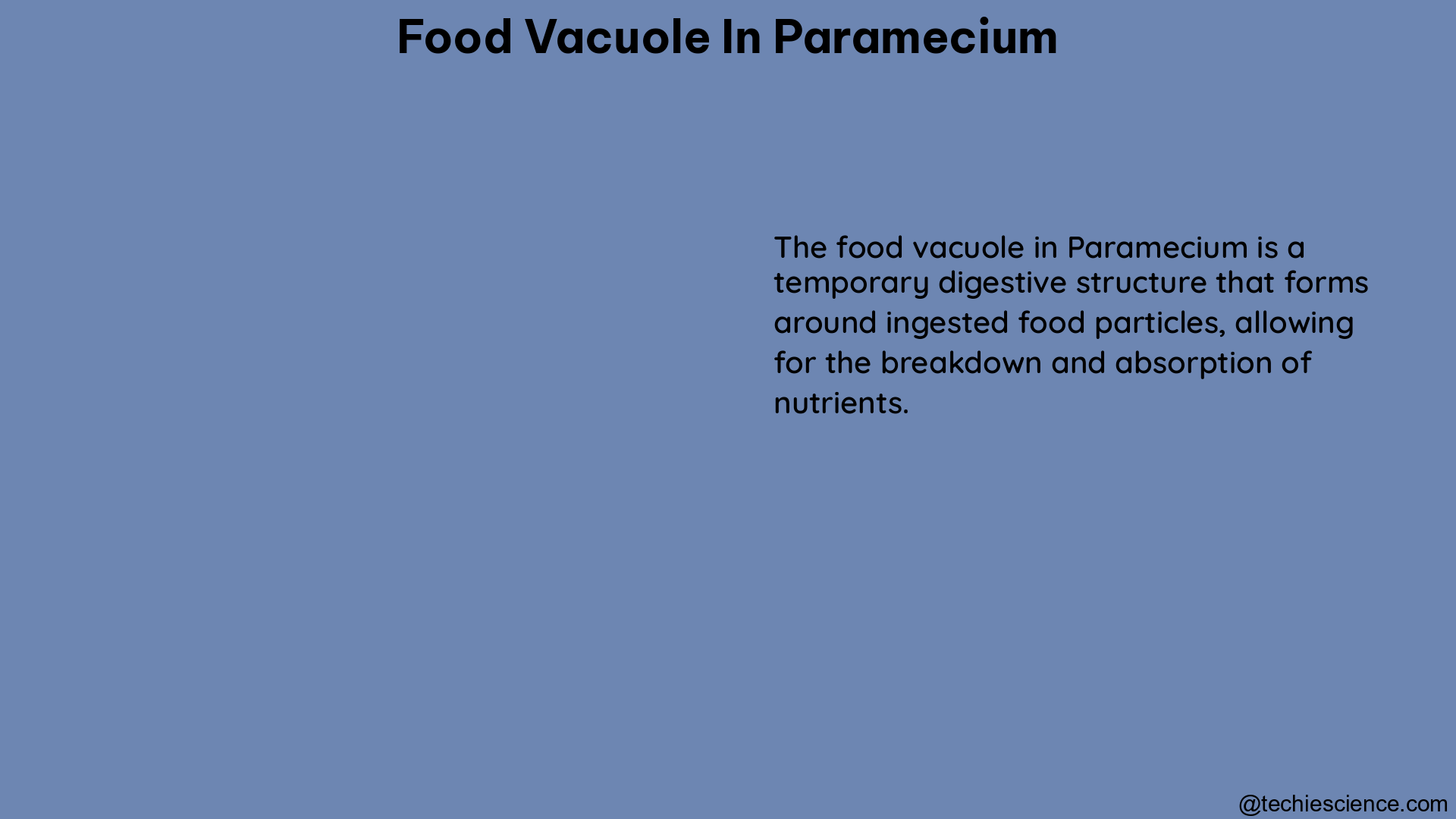The food vacuole in Paramecium is a crucial organelle that plays a vital role in the feeding and digestion processes of this single-celled eukaryotic organism. This dynamic structure undergoes remarkable changes in size, number, and movement, all of which are intricately linked to the availability of membrane material, particle concentration, and the intricate digestive cycle.
Formation and Dynamics of Food Vacuoles
The formation of food vacuoles in Paramecium is dependent on the supply of membrane material. This membrane material is derived from the cell’s plasma membrane, which invaginates to form a food vacuole around the ingested particles or prey. The rate of food ingestion is influenced by the concentration of particles suspended in the culture medium. When Paramecium cells are starved and continuously pressed to form food vacuoles, the rate of food ingestion decreases due to the limited availability of particles in the surrounding environment.
The size of the food vacuole in Paramecium is directly proportional to the concentration of particles in the culture medium. When the particle concentration is higher, the available membrane material is utilized more rapidly, resulting in the formation of larger food vacuoles. Conversely, when the particle concentration is lower, the membrane material is used more slowly, leading to the formation of smaller food vacuoles. After the utilization of the membrane material made available for the cell, a decrease in the number of food vacuoles is observed.
Intracellular Movement and Digestion

The intracellular movement of food vacuoles in Paramecium follows an orderly path, from their formation at the cytostome (the cell’s mouth-like structure) to their eventual egestion at the cytoproct (the cell’s anus-like structure). This dynamic movement can be visualized using confocal microscopy, which allows researchers to observe the flow of pinocytic vesicles from the vacuolar membrane evagination to their fusion with other food vacuoles.
The duration of the digestive cycle in Paramecium is relatively short, ranging from 20 to 60 minutes when the cells are fed with indigestible particles. During this time, the food vacuole undergoes a series of transformations, ultimately becoming “defecation-competent.” At this stage, the food vacuole fuses with the plasma membrane, and the indigestible material is excreted from the cell.
Molecular Architecture and Function
The cytopharyngeal apparatus of Paramecium tetraurelia, which includes the food vacuole, has been extensively studied at the ultrastructural and molecular level. This complex structure is composed of various components, such as the cytostome, cytopharynx, and cytoproct, all of which work in harmony to facilitate the feeding and digestion processes.
The cytopharynx, for example, is a specialized structure that guides the ingested particles into the food vacuole. It is lined with microtubules and microfilaments, which provide structural support and facilitate the movement of the food vacuole. The cytoproct, on the other hand, is responsible for the egestion of the indigestible material from the food vacuole.
At the molecular level, the food vacuole membrane is composed of a variety of proteins and lipids, which play crucial roles in the regulation of pH, the transport of nutrients and waste, and the fusion of the food vacuole with the plasma membrane during the defecation process.
Factors Influencing Food Vacuole Dynamics
Several factors can influence the dynamics of food vacuoles in Paramecium, including:
-
Particle Concentration: As mentioned earlier, the size and number of food vacuoles are directly related to the concentration of particles in the culture medium.
-
Membrane Material Availability: The formation of food vacuoles is dependent on the availability of membrane material, which is derived from the cell’s plasma membrane.
-
Starvation: When Paramecium cells are starved, the rate of food ingestion decreases, as the cells are continuously pressed to form food vacuoles in the absence of sufficient particles.
-
Digestibility of Particles: The duration of the digestive cycle can vary depending on the digestibility of the ingested particles. Indigestible particles may be processed more quickly than digestible ones.
-
pH Regulation: The pH within the food vacuole is tightly regulated, as it plays a crucial role in the digestion of the ingested material.
-
Contractile Vacuole Function: The contractile vacuole, another important organelle in Paramecium, is believed to be involved in the regulation of the food vacuole’s osmotic balance and pH.
Visualization and Experimental Techniques
The study of food vacuoles in Paramecium has benefited greatly from the advancements in microscopy and imaging techniques. Confocal microscopy, for instance, has allowed researchers to visualize the intracellular movement of food vacuoles and the flow of pinocytic vesicles. Additionally, techniques such as electron microscopy have provided detailed insights into the ultrastructural organization of the cytopharyngeal apparatus and the food vacuole membrane.
Experimental approaches, such as the use of fluorescent dyes and genetic manipulation, have also contributed to our understanding of the molecular mechanisms underlying the formation, dynamics, and function of food vacuoles in Paramecium. These techniques have enabled researchers to study the localization and function of specific proteins involved in the regulation of food vacuole processes.
Conclusion
The food vacuole in Paramecium is a remarkable organelle that exemplifies the complexity and adaptability of single-celled eukaryotic organisms. Its dynamic nature, intricate movement patterns, and tight regulation of digestive processes highlight the remarkable capabilities of Paramecium to thrive in diverse environments. By continuing to explore the intricacies of food vacuole biology, researchers can gain valuable insights into the fundamental mechanisms of cellular function, nutrient acquisition, and waste management in these fascinating microorganisms.
References:
- Hall, R. P. (1965). Protozoan Nutrition. Blaisdell Publishing Company, New York.
- Nisbet, B. (1984). Nutrition and Feeding Strategies in Protozoa. Croom Helm, London.
- Radek, R., & Hausmann, K. (1996). Phagotrophy of ciliates. In K. Hausmann & P. C. Bradbury (Eds.), Ciliates: Cells as Organisms (pp. 197-219). Gustav Fischer Verlag, Stuttgart.
- Verni, F., Gualtieri, P., & Dini, F. (2004). The cytopharyngeal apparatus of Paramecium tetraurelia: ultrastructure, molecular architecture, and function. Journal of Eukaryotic Microbiology, 51(5), 448-459.
- https://www.jstor.org/stable/1537967
- https://www.intechopen.com/chapters/37713
- https://journals.biologists.com/jeb/article/200/4/713/7437/How-Does-the-Contractile-Vacuole-of-Paramecium

Hello, I am Bhairavi Rathod, I have completed my Master’s in Biotechnology and qualified ICAR NET 2021 in Agricultural Biotechnology. My area of specialization is Integrated Biotechnology. I have the experience to teach and write very complex things in a simple way for learners.